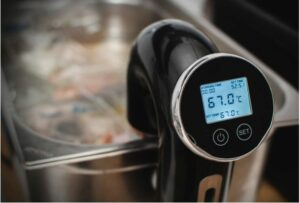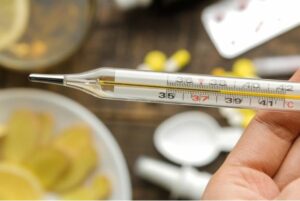In the world of culinary artistry, temperature isn’t just about creating a perfect sear on a steak or achieving the ideal rise in a soufflé. It’s a silent guardian that ensures the safety of our meals, guarding against unseen dangers like bacteria growth and foodborne illnesses. In your kitchen or the bustling environment of a restaurant, maintaining the right food temperature is critical, and here’s why.
Food Safety 101: Understanding the Basics
Before we get into the nitty-gritty, it’s essential to understand the fundamentals of food safety. Harmful bacteria can multiply in the “Danger Zone,” the temperature range between 40°F (4°C) and 140°F (60°C). This can happen rapidly, even within 2 hours, if the food is left out at temperatures within this range. These conditions are the perfect breeding ground for pathogens that can lead to food poisoning or worse. To kill these bacteria, it’s recommended that you cook your food to specific temperatures, known as “safe endpoints.” Learn the Danger Zone Temperature for Food.
Temperature Guidelines for Safety
Each type of food has its safe cooking temperature that is proven to destroy bacteria. These include:
- Ground meat and meat mixtures (like burgers) should be cooked to 160°F (71°C).
- All poultry, including ground chicken and turkey, should be cooked to an internal temperature of 165°F (74°C).
- Fresh meat roasts, steaks, and chops can be cooked to 145°F (63°C) with a three-minute rest time.
- Fish should be cooked to an internal temperature of 145°F (63°C).
- Leftovers and casseroles should be reheated to 165°F (74°C).
Following these guidelines can significantly reduce your risk of consuming contaminated food.
Cooking with Precision: The Use of Thermometers
To ensure that your food is safe, it’s imperative to use a food thermometer. There are various types, from instant-read thermometers to digital probe thermometers, each serving a specific purpose but ultimately working towards the same goal – accuracy.
Types of Food Thermometers
- Bimetallic stemmed thermometer: Good for checking the temperature of thicker foods.
- Digital instant-read thermometer: Perfect for quicker readings and foods with irregular shapes.
- Thermocouples and thermistors: More advanced tools that offer fast and precise readings, suitable for professional kitchens.
By regularly using thermometers, you not only guarantee food safety but also improve the consistency and quality of your cooking.
The Consequences of Temperature Neglect
Foodborne illnesses are no joke. They can cause severe symptoms and hospitalization, and in extreme cases, they can be fatal. Neglecting to monitor food temperatures can lead to outbreaks of food poisoning both at home and in the public sphere.

Case Studies: When Temperatures Go Wrong
There have been numerous cases where temperature mismanagement has led to widespread illness. For example, a catering company failed to maintain appropriate hot holding temperatures for a period of service, resulting in 17 confirmed cases of salmonella. Similar cases have occurred in restaurants and fast-food chains, emphasizing the need for vigilance with food temperatures.
In Practice: A Day in the Life of a Temperature-Conscious Kitchen
Imagine a typical day in a professional kitchen. Chefs and cooks start the day by calibrating their thermometers, checking that they’re in good working order. Throughout the day, they perform spot checks, monitoring not only the internal temperature of cooked dishes but also the storage temperatures of ingredients.
Temperature Checks Throughout the Process
- Receiving: Meats and other perishables are checked upon delivery to ensure they are at the right temperature, rejecting any that aren’t within the safe range.
- Storage: Foods are stored at the correct temperature (either below 40°F or above 140°F) to prevent pathogen growth.
- Preparation: Regular temperature checks are performed during cooking to ensure foods reach their intended safe temperature.
- Serving: Buffet-style setups need constant food temperature monitoring to ensure items remain outside of the Danger Zone.
The Tech Side: How Technology is Revolutionizing Temperature Monitoring
With the advent of the Internet of Things (IoT), temperature monitoring has become more sophisticated and manageable. Wireless temperature sensors can now be used to keep an eye on food and storage conditions without even opening a fridge or walking into a pantry.
Benefits of High-Tech Monitoring
- Constant surveillance: Sensors provide round-the-clock temperature monitoring with automated alerts for any deviations.
- Compliance tracking: Data logging can simplify regulatory compliance by providing detailed temperature history.
- Quality assurance: Technology helps maintain the integrity of food, ensuring it’s served at its most palatable state.
Educating Culinary Practitioners: Training on Temperature Management
A crucial aspect of ensuring food safety is to educate those who handle food. Training programs, especially in professional kitchens, are designed to instil knowledge about the importance of temperature control and the correct use of thermometers.
The Effect of Training on Food Safety
Studies have shown that implementing training can lead to significant improvements in food handling practices, which directly impacts public health. State-of-the-art simulation tools now assist in training, offering a safe and controlled environment to practice temperature checks and management.
The Future of Food Temperatures: Innovations and Predictions
The push for higher food safety standards will continue to bring about innovations in temperature monitoring. We expect to see developments in sensor technology, with smaller, smarter devices providing more accurate and easier methods of checking food temperatures.
What’s on the Horizon for Temperature Safety
Certain industries, such as food delivery services, are investing heavily in temperature control methods. We might soon witness the incorporation of self-chilling containers and more effective packaging solutions that maintain the perfect temperature throughout the delivery process.

Final Thoughts: A Call to Action for Temperature Vigilance
Temperature control is crucial for food safety and a fundamental aspect of cooking. Being precise with temperatures is not only a professional concern but a responsibility for anyone preparing food. It’s a science worth mastering for delicious and safe meals.